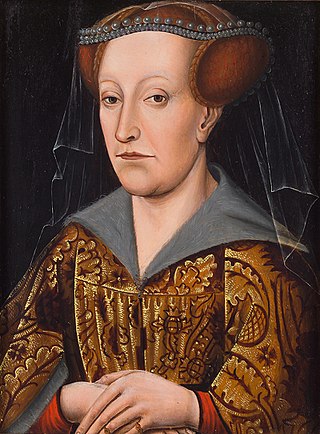Related Research Articles

The Dauphiné is a former province in southeastern France, whose area roughly corresponded to that of the present departments of Isère, Drôme and Hautes-Alpes. The Dauphiné was originally the Dauphiné of Viennois.

Jacqueline, of the House of Wittelsbach, was a noblewoman who ruled the counties of Holland, Zeeland and Hainaut in the Low Countries from 1417 to 1433. She was also Dauphine of France for a short time between 1415 and 1417 and Duchess of Gloucester in the 1420s, if her marriage to Humphrey, Duke of Gloucester, is accepted as valid.

Louis de Bourbon was the third son of John I, Duke of Bourbon and Marie, Duchess of Auvergne. He was Count of Montpensier, Clermont-en-Auvergne and Sancerre and Dauphin of Auvergne and was a younger brother of Charles I of Bourbon. He founded the Bourbon-Montpensier branch of the House of Bourbon, which would eventually take over the Duchy in 1505.

The Count of Valentinois was originally the official in charge of the region (county) around Valence. It evolved in a hereditary title of nobility, still indicating control of the Valentinois and often of the Diois. The title later became the Duke of Valentinois.
William Alnwick was an English Catholic clergyman. He was Bishop of Norwich (1426–1436) and Bishop of Lincoln (1436–1449).

Maria Anna Christine Victoria of Bavaria was Dauphine of France by marriage to Louis, Grand Dauphin, son and heir of Louis XIV. She was known as la Grande Dauphine. The Dauphine was regarded a "pathetic" figure at the court of France, isolated and unappreciated due to the perception that she was dull, unattractive and sickly. She is the ancestor of all Spanish monarchs following her son Philip V.
Paris Dauphine University - PSL is a Grande École and public institution of higher education and research based in Paris, France. As of 2022, Dauphine has 9,400 students in 8 fields of study, plus 3,800 in executive education. Its status as a grand établissement, adopted in 2004, allows it to select its students. On average, 90 to 95% of accepted students received either high distinctions or the highest distinctions at their French High School National Exam results. While not itself having the legal status of a public university, it is a constituent college of PSL University. Dauphine is also a member of the Conférence des Grandes Écoles.

Margaret Stewart was a princess of Scotland and the dauphine of France. She was the firstborn child of King James I of Scotland and Joan Beaufort.
Epicœne, or The Silent Woman, also known as Epicene, is a comedy by Renaissance playwright Ben Jonson. The play is about a man named Dauphine, who creates a scheme to get his inheritance from his uncle Morose. The plan involves setting Morose up to marry Epicoene, a boy disguised as a woman. It was originally performed by the Blackfriars Children, or Children of the Queen's Revels, a group of boy players, in 1609. Excluding its two prologues, the play is written entirely in prose.

The Malwa Sultanate was a late medieval kingdom in the Malwa region, covering the present day Indian states of Madhya Pradesh and south-eastern Rajasthan from 1401 to 1562. It was founded by Dilawar Khan, who following Timur's invasion and the disintegration of the Delhi Sultanate, in 1401, made Malwa an independent realm.
Jeanne d'Auvergne, also Joanna or Joan of Auvergne, is the name of:

Margaret of Nevers, also known as Margaret of Burgundy, was Dauphine of France and Duchess of Guyenne as the daughter-in-law of King Charles VI of France. A pawn in the dynastic struggles between her family and in-laws during the Hundred Years' War, Margaret was regarded as the future Queen of France at two separate times, as a result of her two marriages: first to the Dauphin and second to the Duke of Brittany.
Louis of Savoy, Count of Geneva from 1460, became King of Cyprus in 1459 upon his second marriage to Charlotte of Cyprus, reigning together with and in the right of his wife until 1464. He was the second son and namesake of Louis, Duke of Savoy and his wife, Anne of Lusignan, daughter of King Janus of Cyprus.
William Grey was Bishop of London and then Bishop of Lincoln.

Robert FitzHugh was Bishop of London and Chancellor of the University of Cambridge.
Robert Gilbert was a medieval Bishop of London.
William Wells was a medieval abbot of St. Mary's Abbey, York and Bishop of Rochester.

Clara Gonzaga, Countess of Montpensier, Dauphine of Auvergne, Duchess of Sessa was an Italian noblewoman of the House of Gonzaga. She was the daughter of Federico I Gonzaga, Marquess of Mantua and the wife of Gilbert, Count of Montpensier.
Beatrice of Hungary was a Dauphine of Viennois by marriage to John II of Viennois.
John I, Count of Foix also known as Jean de Foix-Grailly was Count of Foix from 1428 until his death in 1436. He succeeded his mother Isabella, Countess of Foix. His father was Archambaud de Grailly.
References
- ↑ Ward, A.W.; Prothero, G.W.; Leathes, Stanley, eds. (1911). The Cambridge Modern History. Vol. XIII. Cambridge at the University Press.
You can help expand this article with text translated from the corresponding article in French. (March 2022)Click [show] for important translation instructions.
|